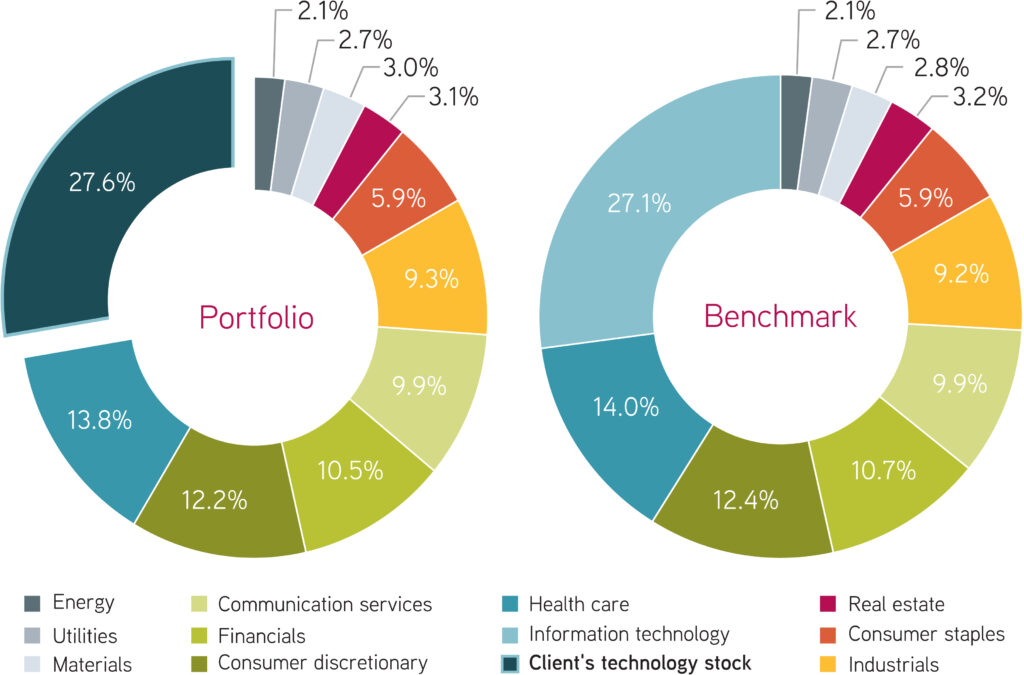

Amassing a large exposure to a single stock may not elicit much concern from an investor. After all, many investors find themselves holding large, concentrated stock positions resulting from good fortune such as equity-linked compensation, an inheritance, or the sale of a business.
As the saying goes, however, you can have too much of a good thing. A heavy concentration of a single stock can increase a portfolio’s risk while reducing diversification benefits.
Unwinding a concentrated single-stock position can be challenging. For taxable investors, liquidating shares means confronting capital gains taxes. Selling stock involves a trade-off between the known up-front tax and transaction costs and the uncertain future benefits of risk reduction. For many investors, capital gains taxes as high as 37% may seem too high a price to pay for diversification. However, it is possible to reduce a portfolio’s single-stock concentration risk over time using a separately managed account (SMA) to alleviate an investor’s risk and tax exposure.
The downside of a concentrated single-stock position
It’s common for investors to find themselves holding a concentrated single-stock exposure. Sometimes, the stock position is that of a current or former employer; other times, it’s the result of a merger or acquisition. As we’ve witnessed with technology shares, the stock may have achieved its dominant position merely by outperforming other holdings.
Investors with concentrated stock positions face the risk that a change in the fortunes of a single company could jeopardize their financial well-being. (Simply ask former employees of Theranos or Enron.)
Because a concentrated stock portfolio can generate massive underperformance, most advisors typically recommend that clients restrict single-stock positions to no more than 10% of portfolio value.
Reducing concentration risk is best approached in stages
Whittling down a hefty stock position is easier when tackled over time. Our Concentrated Stock Position Calculator demonstrates why: Immediately liquidating a concentrated stock portfolio typically results in a high tax bill and lower long-term portfolio returns.
Instead, the process can start with a staged diversification strategy. This methodical approach establishes rules that dictate when portions of concentrated shares can be sold, based on gains or losses in the stock’s price. A staged diversification strategy enables investors to reduce concentrated stock holdings over multiple years while paring portfolio risk.
At the same time, an investor can establish an SMA and invest stock sale proceeds into the account, which allows them to spread realized gains across multiple years.
The SMA can also be customized to provide broad-cap exposure while building the portfolio around the concentrated stock position. For instance, for an investor with an overly large tech exposure, the SMA can exclude the technology sector. An investor’s target exposure can then be adjusted over time as the tech position is reduced. Realized losses in the SMA can be used to help offset taxes resulting from the sale of the concentrated technology stock.
Transforming a concentrated stock portfolio
The illustration below shows how a staged diversification approach, combined with an SMA, can transform a concentrated stock portfolio. Building a broad-cap SMA account around an investor’s tech stock helps to diversify the portfolio without incurring the taxes of fully liquidating the position. Over time, the move from the concentrated technology stock to a diversified broad-cap exposure reduces the portfolio’s stock-specific risk. Harvested losses in the SMA can be used to offset gains from the sale of the concentrated position, helping an investor to diversify tax efficiently over time.

The bottom line
Liquidating a concentrated stock position may appear daunting. Many investors feel loyal to a stock that has performed well, believing that past performance is indicative of future returns. The prospect of facing capital gains taxes can act as an additional deterrent.
But holding onto a concentrated stock position is risky and may put your long-term financial goals in jeopardy. Investors can work with their advisors to reduce risk by establishing a tax-deferred diversification plan that may increase a portfolio’s value over time and reduce single-stock concentration.

With an aging advisor population, report looks at demographics, structures.

Formerly Fidelity Investments leader will drive move to comprehensive services.

Lawmakers decided not to agree compromise proposal in Trump tax bill.

Despite a tricky political environment, the Wall Street bank still has a goal.

A House bill could stop the SEC from blocking closed-end funds' private fund investments.
Orion's Tom Wilson on delivering coordinated, high-touch service in a world where returns alone no longer set you apart.
Barely a decade old, registered index-linked annuities have quickly surged in popularity, thanks to their unique blend of protection and growth potential—an appealing option for investors looking to chart a steadier course through today's choppy market waters, says Myles Lambert, Brighthouse Financial.
